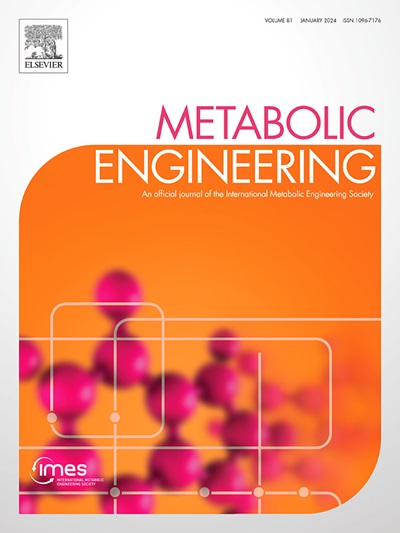Modeling host–pathway dynamics at the genome scale with machine learning
IF 6.8
1区 生物学
Q1 BIOTECHNOLOGY & APPLIED MICROBIOLOGY
引用次数: 0
Abstract
Pathway engineering offers a promising avenue for sustainable chemical production. The design of efficient production systems requires understanding complex host–pathway interactions that shape the metabolic phenotype. While genome-scale metabolic models are widespread tools for studying static host–pathway interactions, it remains a challenge to predict dynamic effects such as metabolite accumulation or enzyme overexpression during the course of fermentation. Here, we propose a novel strategy to integrate kinetic pathway models with genome-scale metabolic models of the production host. Our method enables the simulation of the local nonlinear dynamics of pathway enzymes and metabolites, informed by the global metabolic state of the host as predicted by Flux Balance Analysis (FBA). To reduce computational costs, we make extensive use of surrogate machine learning models to replace FBA calculations, achieving simulation speed-ups of at least two orders of magnitude. Through case studies on two production pathways in Escherichia coli, we demonstrate the consistency of our simulations and the ability to predict metabolite dynamics under genetic perturbations and various carbon sources. We showcase the utility of our method for screening dynamic control circuits through large-scale parameter sampling and mixed-integer optimization. Our work links together genome-scale and kinetic models into a comprehensive framework for computational strain design.
用机器学习在基因组尺度上模拟动态宿主途径相互作用
途径工程为可持续化工生产提供了一条有前途的途径。高效生产系统的设计需要了解形成代谢表型的复杂宿主途径相互作用。虽然基因组尺度的代谢模型是研究静态宿主途径相互作用的广泛工具,但预测发酵过程中代谢物积累或酶过表达等动态效应仍然是一个挑战。在此,我们提出了一种新的策略,将动力学途径模型与生产宿主的基因组尺度代谢模型相结合。我们的方法能够模拟途径酶和代谢物的局部非线性动力学,并通过通量平衡分析(FBA)预测宿主的整体代谢状态。为了降低计算成本,我们广泛使用代理机器学习模型来取代FBA计算,实现了至少两个数量级的模拟加速。通过对大肠杆菌两种生产途径的案例研究,我们证明了模拟的一致性以及预测遗传扰动和各种碳源下代谢物动力学的能力。我们展示了通过大规模参数采样和混合整数优化筛选动态控制电路的方法的实用性。我们的工作将基因组尺度和动力学模型连接到一个计算应变设计的综合框架中。
本文章由计算机程序翻译,如有差异,请以英文原文为准。
求助全文
约1分钟内获得全文
求助全文
来源期刊

Metabolic engineering
工程技术-生物工程与应用微生物
CiteScore
15.60
自引率
6.00%
发文量
140
审稿时长
44 days
期刊介绍:
Metabolic Engineering (MBE) is a journal that focuses on publishing original research papers on the directed modulation of metabolic pathways for metabolite overproduction or the enhancement of cellular properties. It welcomes papers that describe the engineering of native pathways and the synthesis of heterologous pathways to convert microorganisms into microbial cell factories. The journal covers experimental, computational, and modeling approaches for understanding metabolic pathways and manipulating them through genetic, media, or environmental means. Effective exploration of metabolic pathways necessitates the use of molecular biology and biochemistry methods, as well as engineering techniques for modeling and data analysis. MBE serves as a platform for interdisciplinary research in fields such as biochemistry, molecular biology, applied microbiology, cellular physiology, cellular nutrition in health and disease, and biochemical engineering. The journal publishes various types of papers, including original research papers and review papers. It is indexed and abstracted in databases such as Scopus, Embase, EMBiology, Current Contents - Life Sciences and Clinical Medicine, Science Citation Index, PubMed/Medline, CAS and Biotechnology Citation Index.
 求助内容:
求助内容: 应助结果提醒方式:
应助结果提醒方式:


